
- •Initializing with Constructor Functions . . . . .
- •Into a Web page as a separate section. Although JavaScript code can
- •Is that standard php script delimiters are guaranteed to be available
- •In the block. Any text or lines between the opening /* characters and
- •2.7541 Are not integers; they are floating-point numbers. A floating-
- •Value 300
- •Is a value of 2.5, because 6 goes into 15 exactly 2.5 times. But if you
- •IsEven.Php.
- •Ing example,
- •Ing curly brace is on its own line following the function statements.
- •In php 3 and earlier, it was necessary to put a function definition
- •Is called an iteration. When the conditional expression evaluates
- •Including Files
- •13. Close your Web browser window.
- •Including Files
- •In php, you can also use two operators to combine strings. The first
- •Xhtml source code gen-
- •Input. Php provides several functions for manipulating the case of a
- •Is uppercase. If you need the reverse of ucfirst(), the lcfirst()
- •In some situations, you will need to find and extract characters and
- •Information Interchange, or ascii, which are numeric represen-
- •In comparison, the following preg_match() function returns a value
- •In the pattern is optional. The following code demonstrates how to
- •Values; any strings you validate against a regular expression must
- •Value of 1 because the top-level domain contains a valid value of .Com.
- •Is submitted using the “post” method, the form data is embedded in
- •Validating String Data
- •Xhtml tags or character entities. The message field is a text string
- •Value of the header element. For example:
- •Xhtml code within a php script section.
- •Is typically the person who created the resource. Otherwise, the net-
- •If even a single character of the Web page is sent prior to sending
- •Variables to the file_put_contents() function.
- •Xhtml hyperlink. To download a file from outside the xhtml
- •If...Else statement to display the appropriate version of the mes-
- •Iterating Through an Array
- •Iterating Through an Array
- •In Chapter 2, you learned how to use a foreach statement to iterate
- •Iterating Through an Array
- •Iterating Through an Array
- •In comparison, the following code declares and initializes
- •If ((!file_exists("MessageBoard/messages.Txt"))
- •Values from the array to create a thumbnail gallery of images in which
- •Introduction to Databases
- •Including php, allow you to create Web pages that can read and write
- •Introduction to Databases
- •Information that can be organized into ordered sets of data, and
- •Information. Each recipe in a recipe database, for instance, is a single
- •Introduction to Databases
- •Index, which identifies records in a database to make retrievals and
- •In a single table. However, you might want to break the information
- •Into multiple tables to better organize it into logical sets. Another
- •Information in one of the tables confidential and accessible only by
- •Is the employee information table from Figure 7-1. The related table
- •Is a payroll table that contains confidential salary and compensation
- •Information. Notice that each table contains an identical number of
- •Introduction to Databases
- •Introduction to Databases
- •In a junction
- •Introduction to Databases
- •In a relational format is called a relational database management
- •Is a standard data manipulation language among many dbmSs.
- •Into the query area at the top of the screen or by dragging tables and
- •It is important to understand that even though many dbmSs sup-
- •Introduction to Databases
- •If you ever
- •Is. In comparison, the bigint data type stores integer values between
- •5 Rows in set (0.00 sec)
- •Int);[enter ]
- •Important, these two tabs can cause you to lose all of the data in the
- •Internet Explorer to export the table, click the Save button in the File
- •Ifies the table being changed and the change to make.
- •It easier for you to write php code that can be used with a variety of
- •Information about queries that match one of the following formats:
- •Various types of actions, depending on the type of query.
- •Include fields for the date and time of the flight, flight number, and
- •In the ChineseZodiac folder and upload the file to the server. Open
- •Including white space,
- •Information on a Web server. When you start a new session, the
- •Introduction to Object-Oriented Programming
- •Introduction to Object-Oriented
- •Variables associated with an object are called properties or attributes.
- •In the Loan object example, a function that calculates the number of
- •Introduction to Object-Oriented Programming
- •Introduction to Object-Oriented Programming
- •Include instances of objects inherit the object’s functionality.
- •In this chapter, you will create the Web site for an online order form
- •In an online store application. The application includes information
- •Ity of building a working online store. Online store classes are very
- •Information and products. The OnlineStore class requires that store
- •Information is stored in a table containing six fields: storeId, name,
- •Information. Instead, the class simply uses session iDs to keep track
- •Variable and function as necessary, without bothering with all this
- •In a class
- •Is developed. Imagine what would happen if Microsoft distributed
- •Ing class is invalid because it does not include an access specifier:
- •If they will not be supported by future xhtml versions or are not
- •Xhtml standards. To review the guide of current w3c css specifi-
- •Information to remind yourself or others of what the code is doing. A
- •Xhtml document to the external style sheet. This link informa-
- •If you select Apache from the WampServer menu and select Service
- •Ing code uses the number_format() function to add comma separa-
- •In data that a user submits to a php script.
- •Value of “On” and the display_startup_errors directive is assigned
- •Instead. By looking at the source code, you could see that the value of
- •Ing engine can even help locate logic errors.
- •In Chapter 8, along with the equivalent mssql_* functions, where
- •Inline styles, 632
- •Xhtml, 620–635 (continued)
The PHP Group officially recommends that you use standard PHP
script delimiters to write PHP code declaration blocks. One reason
Is that standard php script delimiters are guaranteed to be available
on any Web server that supports PHP. (As you will learn shortly, both
short PHP script delimiters and ASP-style script delimiters can be
disabled.) However, the primary reason for using standard PHP script
delimiters is that they are the only method that is completely compli-
ant with XML. (The Web page examples and exercises in this book
are written in XHTML, which is based on XML.) XML is preferred
for Web development not only because it is the basis of XHTML
documents, but because it has become the standard for exchanging
data on the Internet. For this reason, you should always ensure that
any Web pages or scripts you create are compliant with XML.
Creating
PHP Code Blocks
Even
though the PHP Group officially recommends that you use stan-
dard
PHP script delimiters to write PHP, some Web developers prefer
the
other types of code declaration blocks, so you should be able to
recognize
the other delimiters when you see them.
To
create a PHP script that contains standard PHP script delimiters:
1.
2.
5
Create
a new document in your text editor.
Type
the <!DOCTYPE>
declaration,
<html>
element,
header
information,
and <body>
element.
Use the strict DTD and
“PHP
Code Blocks” as the content of the
Your document should appear as follows:
<!DOCTYPE html PUBLIC "-//W3C//DTD XHTML 1.0
Strict//EN"
"http://www.w3.org/TR/xhtml1/DTD/xhtml1-strict.dtd">
<html xmlns="http://www.w3.org/1999/xhtml">
<head>
<title>PHP Code Blocks</title>
<meta http-equiv="content-type"
content="text/html; charset=iso-8859-1" />
</head>
<body>
</body>
</html>
3.
Add the following paragraph element and standard PHP
script delimiters to the document body. Be sure to nest the
script delimiters within the paragraph element. The paragraph
element forces the output from the script delimiters to render
on a separate line.
<p>
<?php
?>
</p>
4.
Add the following echo statement (shown in bold) between
the script delimiters:
<p>
<?php
echo "This text is displayed using standard PHP
script delimiters. ";
?>
</p>
5.
Save the document as PHPCodeBlocks.php in the Chapter
directory for Chapter 1. Be sure to use an extension of .php,
which is required for your Web server to recognize the file as
a PHP script.
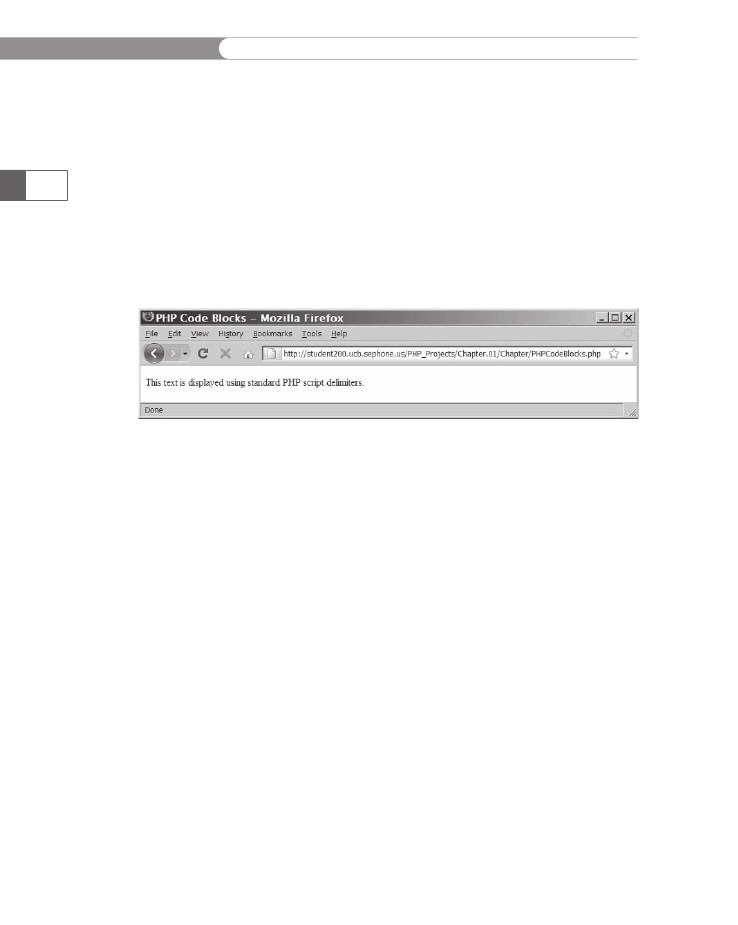
CHAPTER
1
Getting
Started with PHP
6.
Use
FTP to upload the PHPCodeBlocks.php file to the Web
server.
Once you have successfully uploaded the docu-
ment,
validate it with the W3C XHTML Validator at http://
validator.w3.org/.
(Instructions for validating XHTML
documents
are included in Appendix A.)
Open
the PHPCodeBlocks.php file in your Web browser
by
entering the following URL: http://<yourserver>/
PHP_Projects/Chapter.01/Chapter/PHPCodeBlocks.php
(replacing
<yourserver> with the name of the Web server
provided
by your instructor). You should see the Web page
shown
in Figure 1-1.
6
7.
Figure
1-1
Output
of a PHP script with standard PHP script delimiters
8.
Close
your Web browser window.
The
<script> Element
A
second option for creating PHP code blocks is to use the XHTML
<script>
element.
When the <script>
element
is used with PHP,
you
must assign a value of “php” to the language
attribute
of the
<script>
element
to identify the code block as PHP. When the PHP
scripting
engine encounters a <script>
element
with “php” assigned
to
its language
attribute,
it processes any code within the element
as
PHP on the server before returning the Web page. The syntax for
using
PHP with the <script>
element
is as follows:
<script
language="php">
statements;
</script>
The
following example contains the same echo
statement
you saw
with
the standard PHP script delimiters, but this time the statement
is
contained within a PHP <script>
element:
<script
language="php">
echo
"Explore Africa!";
</script>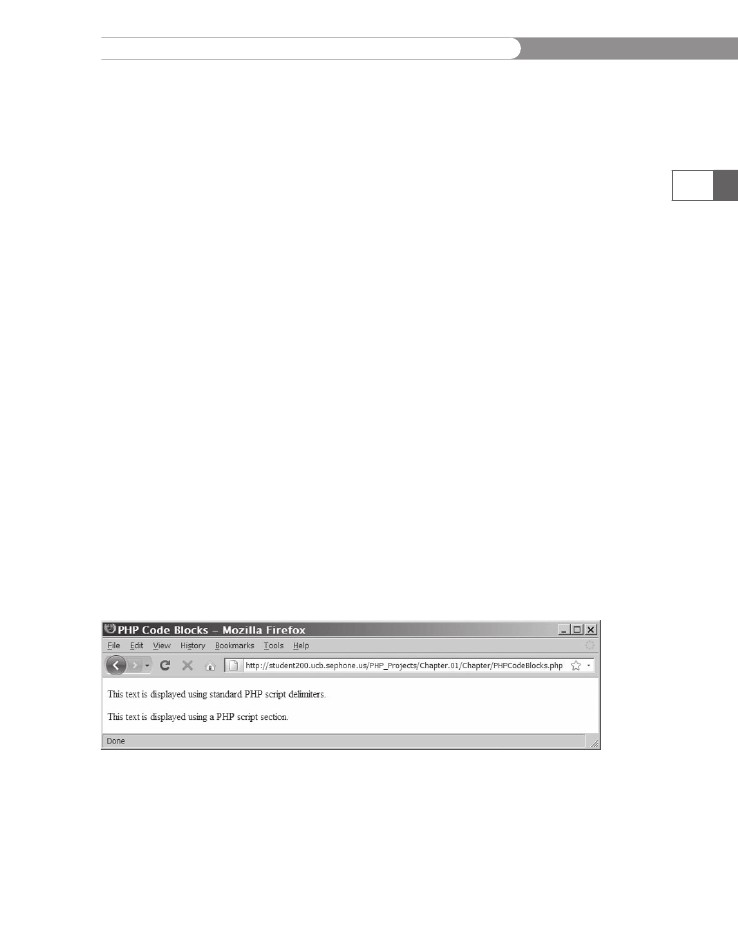
Creating
PHP Code Blocks
Like
the standard PHP script delimiters, the <script>
element
is
always
available on any Web server that supports PHP. Unfortunately,
the
<script>
element’s
language
attribute
is deprecated in XHTML.
Further,
the scripting engine ignores <script>
elements
that include
the
type
attribute,
which is required for compatibility with both the
strict
and transitional DTDs. For this reason, you cannot validate
documents
that include PHP <script>
elements.
To
add a PHP <script>
element
to the PHPCodeBlocks.php
document:
1.
7
Return
to the PHPCodeBlocks.php document in your text
editor.
Add
the following paragraph element and <script>
element
to
the end of the document body:
<p>
<script
language="php">
</script>
</p>
2.
3.
Add
the following echo
statement
(shown in bold) between
the
script delimiters:
<p>
<script
language="php">
echo
"This text is displayed using a PHP script
section.";
</script>
</p>
4.
Save
the PHPCodeBlocks.php document, upload it to the
Web
server, and then open it from your Web server. Your
Web
browser should appear similar to Figure 1-2.
Figure
1-2
5.
Output
of a PHP script after adding a PHP script section
Close
your Web browser window.
CHAPTER
1
Getting
Started with PHP
Short
PHP Script Delimiters
A
simplified method of writing PHP code declaration blocks is to use
the
short <?
and
?>
script
delimiters. Short PHP script delimiters are
similar
to standard PHP script delimiters, except they do not include
‘php’
in the opening delimiter. The syntax for short PHP script delim-
iters is as follows:
<? statements; ?>
8
The following example shows how to use short delimiters with the
echo statement you saw earlier:
<? echo "Explore Africa!"; ?>
Unlike the <?php and ?> script delimiters and the <script> element,
which are always available on any Web server that supports PHP, the
short <? and ?> delimiters can be disabled in a Web server’s php.ini
configuration file. Because a Web server on which your PHP script
will run might not always be under your control, the PHP Group
discourages the use of short delimiters, especially when developing
scripts that will be redistributed and used by other Web develop-
ers. Although you can use short PHP script delimiters if you prefer,
your PHP scripts will not work if your Web site is hosted by an ISP
that does not support short PHP script delimiters. Another reason to
avoid the short <? and ?> delimiters is that you cannot use them in
XML documents, although you can use them in XHTML documents,
including documents that conform to the strict DTD. With XML
documents, you must use the <?php and ?> script delimiters.
To add short PHP script delimiters to the PHPCodeBlocks.php
document:
1.
Return to the PHPCodeBlocks.php document in your text
editor.
Add the following paragraph element and short PHP script
delimiters to the end of the document body:
<p>
<?
?>
</p>
2.
3.
Add the following echo statement (highlighted in bold)
between the script delimiters:
<p>
<?
echo "This text is displayed using short PHP
script delimiters.";
?>
</p>
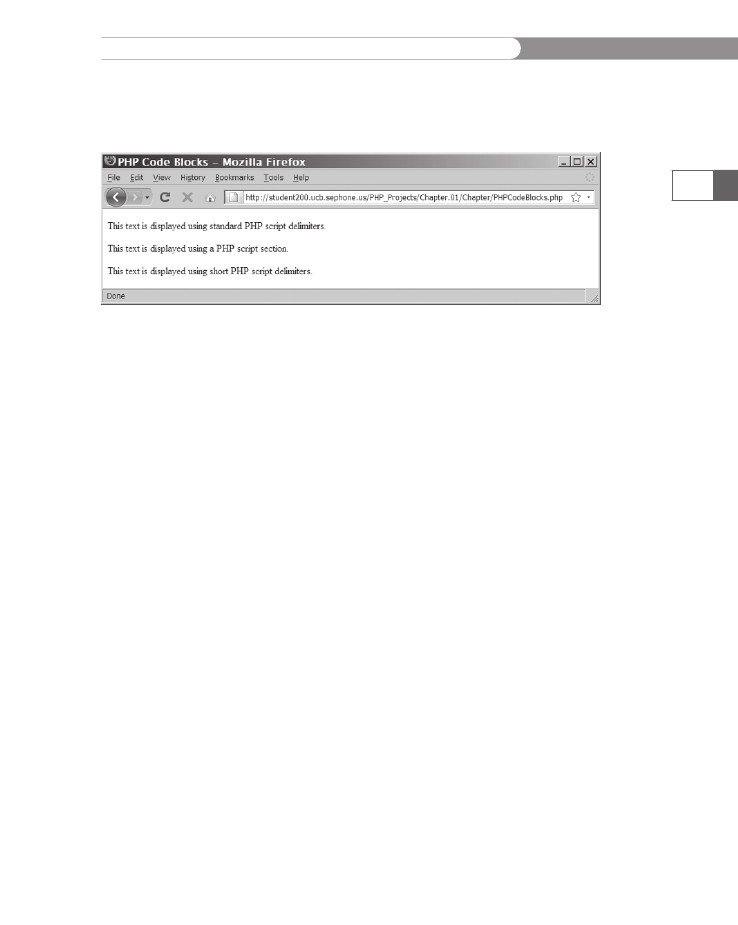
Creating
PHP Code Blocks
4.
Save
the PHPCodeBlocks.php document, upload it, and open
it
from your Web server. Your Web browser should appear
similar
to Figure 1-3.
9
Figure
1-3
5.
Output
of a PHP script after adding short PHP script delimiters
Close
your Web browser window.
ASP-Style
Script Delimiters
Some
Web developers prefer to use the ASP-style script delimiters of
<%
and %> to develop PHP scripts. The syntax for ASP-style script
delimiters
is similar to that of short PHP script delimiters, as follows:
<%
statements; %>
The
following example shows how to use ASP-style script delimiters
with
the echo
statement
you saw earlier:
<%
echo "Explore Africa!"; %>
Like
short PHP script delimiters, ASP-style script delimiters are com-
pliant
with XHTML, including the strict DTD, but not with XML.
ASP-style
script delimiters can also be enabled or disabled in the
php.ini
configuration file, so you should not use them unless you are
sure
they are enabled on any Web servers on which your PHP scripts
will
run. Unless you are a hard-core ASP developer who only uses
PHP
occasionally, or if you are using an HTML editor that does not
support
PHP script delimiters, there is little reason to use ASP-style
script
delimiters.
To
add ASP-style script delimiters to the PHPCodeBlocks.php
document:
1.
Return
to the PHPCodeBlocks.php document in your text
editor.
CHAPTER
1
Getting
Started with PHP
2.
Add
the following paragraph element and ASP-style script
delimiters
to the end of the document body:
<p>
<%
%>
</p>
10
3.
Add
the following echo
statement
(shown in bold) between
the
script delimiters:
<p>
<%
echo
"This text is displayed using ASP-style
script
delimiters.";
%>
</p>
4.
Save
the PHPCodeBlocks.php document, upload it, and open
it
from your Web server. Your Web browser should appear
similar
to Figure 1-4.
Figure
1-4
Output
of a PHP script after adding ASP-style script delimiters
5.
Close
your Web browser window.
Understanding
Functions
Before
you start writing PHP scripts, you need to understand the
basics
of functions. The term function refers to a subroutine (or
individual
statements grouped into a logical unit) that performs a
specific
task. PHP includes numerous built-in functions that perform
various
types of tasks. You will work with many built-in PHP func-
tions
throughout this book. To execute a function, you must invoke,
or
call, it from somewhere in your script. The statement that calls a
function
is referred to as a function call and consists of the function
name
followed by any data that the function needs. The data (which
you
place in parentheses following the function name) are called
Creating
PHP Code Blocks
arguments
or actual parameters. Sending data to a called function
is
called passing arguments. Many functions generate, or return,
some
sort of a value that you can use in your script. For example, PHP
includes
a round()
function
that rounds a decimal value to the near-
est
whole number. You pass a number as an argument to the round()
function,
which calculates and returns the nearest whole number.
The
following statement calls the round()
function
and passes to it
a
value of 3.556. The round()
function
calculates and returns a value
of
4, which is then displayed with an echo
statement.
<?php
echo round(3.556); ?>
11
Many
functions can accept multiple arguments, which you separate
with
commas. For example, the second argument you pass to the
round()
function
determines the number of digits after the decimal
point
that it should use to round the number. The following state-
ment
calls the round()
function
and then passes to it a first argument
of
3.556 and a second argument of 2. The round()
function
calculates
and
returns a value of 3.56 (rounded to two decimal places), which is
then
displayed with an echo
statement.
<?php
echo round(3.556, 2); ?>
You
learn more
about
func-
tions,
including
how
to create
your
own, in
Chapter
2.
To
create a PHP script that uses the phpinfo()
function
to create a
Web
page that lists diagnostic information for the current PHP con-
figuration
on the Web server:
1.
2.
Create
a new document in your text editor.
Type
the <!DOCTYPE>
declaration,
<html>
element,
header
information,
and <body>
element.
Use the strict DTD and “PHP
Diagnostic
Information” as the content of the <title>
element.
Add
the following standard PHP script delimiters and
phpinfo()
function
to the document body. Be certain to
include
the parentheses and semicolon in the statement con-
taining
the phpinfo()
function.
<?php
phpinfo();
?>
3.
4.
Save
the document as PHPTest.php in the Chapter direc-
tory
for Chapter 1 and upload the document to the Web
server.
You will not be able to validate this page with the W3C
XHTML
Validator because the phpinfo()
function
inserts a
second
set of HTML headers.
Open
the PHPTest.php file in your Web browser by entering
the
following URL: http://<yourserver>/PHP_Projects/Chap-
ter.01/Chapter/PHPTest.php.
You should see a Web page
5.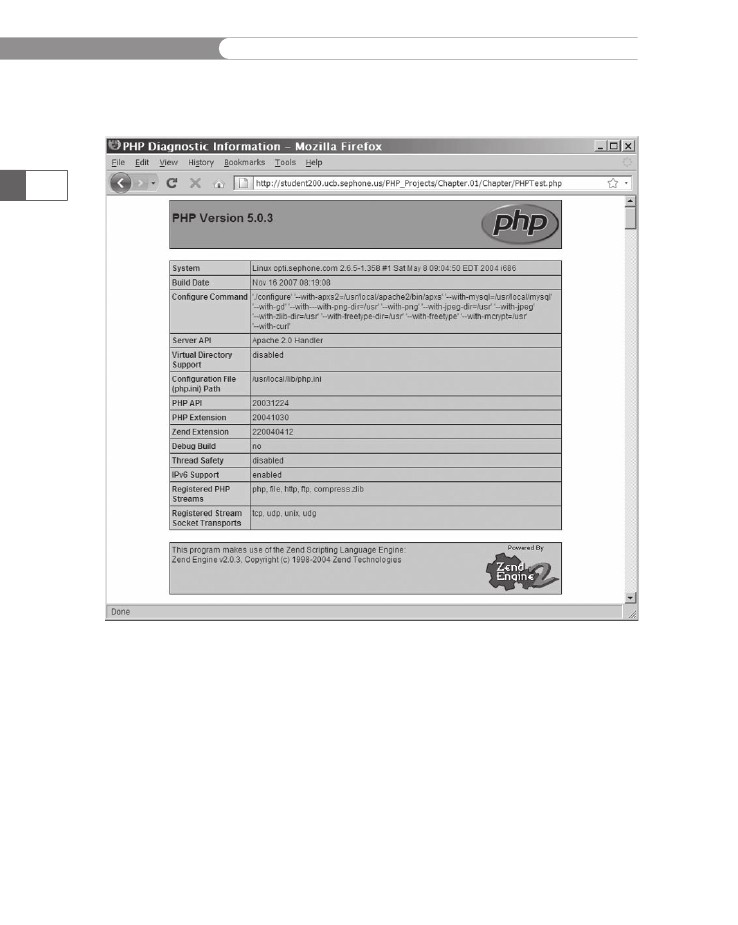
CHAPTER
1
Getting
Started with PHP
similar
to the one shown in Figure 1-5, which lists diagnostic
information
for PHP.
12
Figure
1-5
PHP
Diagnostic Information Web page
6.
Close
your Web browser window.
Displaying
Script Results
When
you write a PHP script, you will often want to display the
results
of the script in the Web page that is returned as a response
to
a client. For example, you might want the Web page to display
database
records that the client requested or the result of a calcula-
tion
that was processed by the PHP script. Recall that the scripting
engine
ignores any non-PHP code and only processes the PHP code
it
finds within PHP code blocks. The Web server then returns the
Creating
PHP Code Blocks
results
of the PHP script and any HTML or XHTML elements found
in
the PHP file to the client, where it is rendered by the client’s
Web
browser.
To return these script results to the client, you must use an
echo
statement,
which you’ve already seen, or the print
statement.
The
echo
and
print
statements
create new text on a Web page that
is
returned as a response to a client.
You
might be thinking that the echo
and
print
statements
are func-
tions.
Actually, they are not functions, but language constructs of the
PHP
programming language. A programming language construct
refers
to a built-in feature of a programming language. The echo
and
print
statements
are nearly identical, but they have some differences.
For
example, the print
statement
returns a value of 1 if it is success-
ful
or a value of 0 if it is not successful, while the echo
statement
does
not
return a value. You need to learn a little more about functions
before
you can understand why the print
statement
returns a value.
However,
keep in mind that you can use the exact same syntax with
the
print
statement
that you use with the echo
statement.
To
modify the PHPCodeBlocks.php document so it uses print
state-
ments
instead of echo
statements:
1.
13
Return
to the PHPCodeBlocks.php document in your text
editor.
Replace
each of the echo
statements
with a print
statement.
For
example, the statement within the standard PHP script
delimiters
should read as follows:
<?php
print
"This text is displayed using standard PHP
script
delimiters.";
?>
2.
3.
Save
the PHPCodeBlocks.php document, upload it, and then
open
it from your Web server. The document should render
the
same as it did with the echo
statements.
Close
your Web browser window.
4.
You
should understand that the only reason to use the echo
and
print
statements
is to include the results of a PHP script within a
Web
page that is returned to a client. For example, you might want
to
return a new Web page based on information a user enters into a
form
for an online transaction and submits to a Web server. You can
use
a PHP script to process the submitted information and return a
new
Web page to the client that displays the sales total, order con-
firmation,
and so on. If you simply want to display text in a Web
page
that is returned to the client, there is no need to use anything
but
standard XHTML elements. The procedures for submitting and
CHAPTER
1
Getting
Started with PHP
processing
data are a little too complicated for this introductory
chapter.
In this chapter, you use the echo
and
print
statements
to
return
the results of a script to a client in order to learn the basics
of
PHP.
14
For
both the echo
and
print
statements,
you need to include a text
string
that contains the text that will appear in the Web browser. A
literal
string is text that is contained within double or single quota-
tion
marks. As you saw earlier, the following echo
statement
uses
double
quotation marks to display the text “Explore Africa!” in the
Web
browser window:
<?php
echo "Explore Africa!"; ?>
You
can also use single quotation marks with the preceding echo
statement,
as follows:
<?php
echo 'Explore Africa!'; ?>
The
echo
and
print
statements
support multiple arguments. If you
want
to pass multiple arguments to the echo
and
print
statements,
separate
them with commas, just as with arguments passed to a func-
tion.
In the following example, three text string arguments are passed
to
the echo
statement:
<?php
echo "Explore Africa, ", "South America, ",
"
and Australia!"; ?>
To
create a script that passes multiple arguments to an echo
statement:
1.
2.
Create
a new document in your text editor.
Type
the <!DOCTYPE>
declaration,
<html>
element,
header
information,
and <body>
element.
Use the strict DTD and
“How
to Talk Like a Pirate” as the content of the
element.
Add the following heading element to the document body:
<h1>How to Talk Like a Pirate</h1>
3.
4.
Next, add paragraph tags and a standard PHP script delimiter
to the end of the document body:
<?php
?>
5.
Now add the following echo statement to the PHP code block:
echo "Avast me hearties! ",
"Return handsomely with some fine swag, ye
scurvy dogs! ",
"Else, we be keelhaulin' ye' next morn . . . ";

Creating
PHP Code Blocks
6.
Save
the document as PirateTalk.php in the Chapter direc-
tory
for Chapter 1, and upload the document to the Web
server.
After you upload the document, attempt to validate it
with
the W3C XHTML Validator. You will get a “text is not
allowed
here” error, which you will fix in a later exercise.
Open
the PirateTalk.php file from your Web server by enter-
ing
the following URL: http://<yourserver>/PHP_Projects/
Chapter.01/Chapter/PirateTalk.php.
Your Web browser
should
appear similar to Figure 1-6.
15
7.
Figure
1-6
“How
to Talk Like a Pirate” Web page
8. Close your Web browser window.
You can also use parentheses with the echo and print statements in
the same manner that you use them with functions, as follows:
<?php echo("Explore Africa, ", "South America, ",
" and Australia!"); ?>
You will not use parentheses with most of the echo and print state-
ments you write in this book. However, you should be able to recog-
nize the parenthesized version as just another form of the echo and
print statements, not a separate type of function.
So far, the arguments you have seen and used with the echo state-
ments have consisted of plain text that is rendered in the Web
browser’s default font. To format the output of text that is displayed
with echo and print statements, you can use any XHTML formatting
elements you want as part of the text string arguments. The following
code shows a modified version of the previous script, but this time
the echo statement includes several XHTML elements to format the
appearance of the text string in a Web browser. Figure 1-7 shows how
the script is rendered in a Web browser.
<?php echo "<p>Explore <strong>Africa</strong>, <br />",
"<strong>South America</strong>, <br />",
" and <strong>Australia</strong>!</p>"; ?>
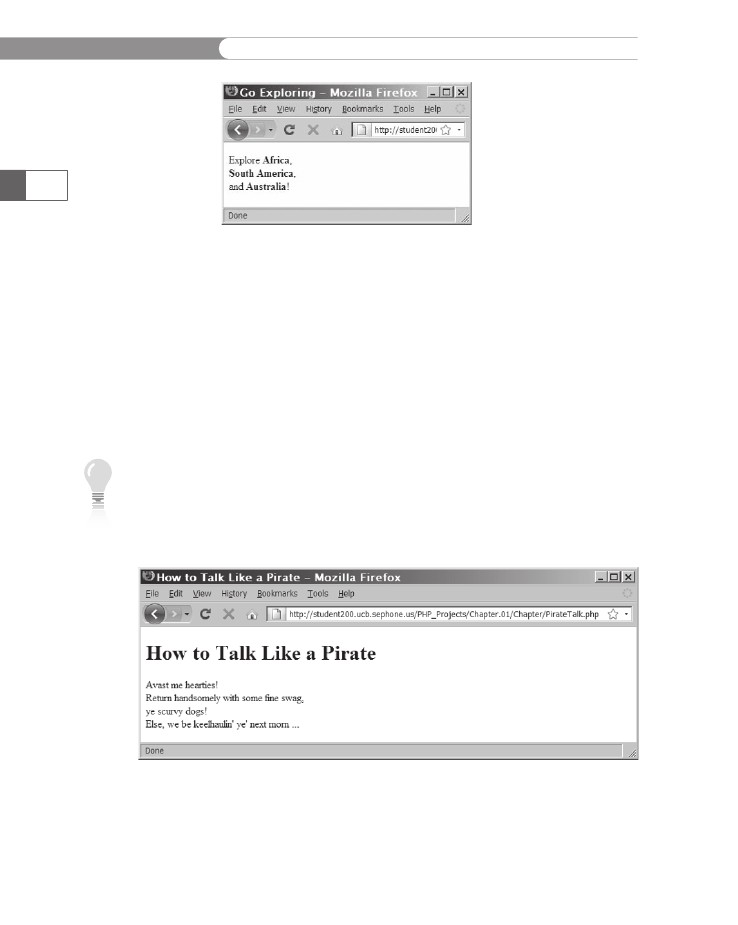
CHAPTER
1
Getting
Started with PHP
16
Figure
1-7 Output of an echo
statement
with
XHTML elements
To
modify the PirateTalk.php script so the echo
statement
includes
XHTML
elements:
1.
2.
Return
to the PirateTalk.php script in your text editor.
Modify
the values passed to the echo
statement
so they
include
paragraph and line break elements, as follows:
echo
"<p>Avast me hearties!<br />",
"Return
handsomely with some fine swag,<br />ye
scurvy dogs!<br />",
"Else, we be keelhaulin' ye' next morn . . . </p>";
You study
additional
techniques for
working with
text strings in
Chapter 3.
3.
Save the PirateTalk.php file and upload it to the Web server.
Validate the document with the W3C XHTML Validator (the
error should be gone now), and then open the document from
your Web server. The document should appear similar to
Figure 1-8.
Figure 1-8 “How to Talk Like a Pirate” Web page after adding XHTML elements to the
echo statement
4. Close your Web browser window.
Creating
PHP Code Blocks
Creating
Multiple Code Declaration Blocks
You
can include as many PHP script sections as you want within a
document.
However, when you include multiple script sections in a
document,
you must include a separate code declaration block for
each
section. The following document includes two separate script
sections.
The script sections create the information that is displayed
beneath
the <h2>
heading
elements.
...
</head>
<body>
<h1>Multiple
Script Sections</h1>
<h2>First
Script Section</h2>
<?php
echo "<p>Output from the first script
section.</p>";
?>
<h2>Second
Script Section</h2>
<?php
echo "<p>Output from the second script
section.</p>";
?>
</body>
</html>
17
Remember
that PHP code declaration blocks execute on a Web server
before
a Web page is sent to a client. If users were to view the source
document
after they received the PHP document, they would not
see
any PHP code declaration blocks. Instead, the users would only
see
the results returned from the PHP code. The following example
shows
how the source code for the preceding document appears after
a
user receives it. Notice that the PHP code declaration blocks have
been
converted to elements and text. Figure 1-9 shows how the text
and
elements appear in a Web browser.
...
</head>
<body>
<h1>Multiple
Script Sections</h1>
<h2>First
Script Section</h2>
<p>Output
from the first script section.</p>
<h2>Second
Script Section</h2>
<p>Output
from the second script section.</p>
</body>
</html>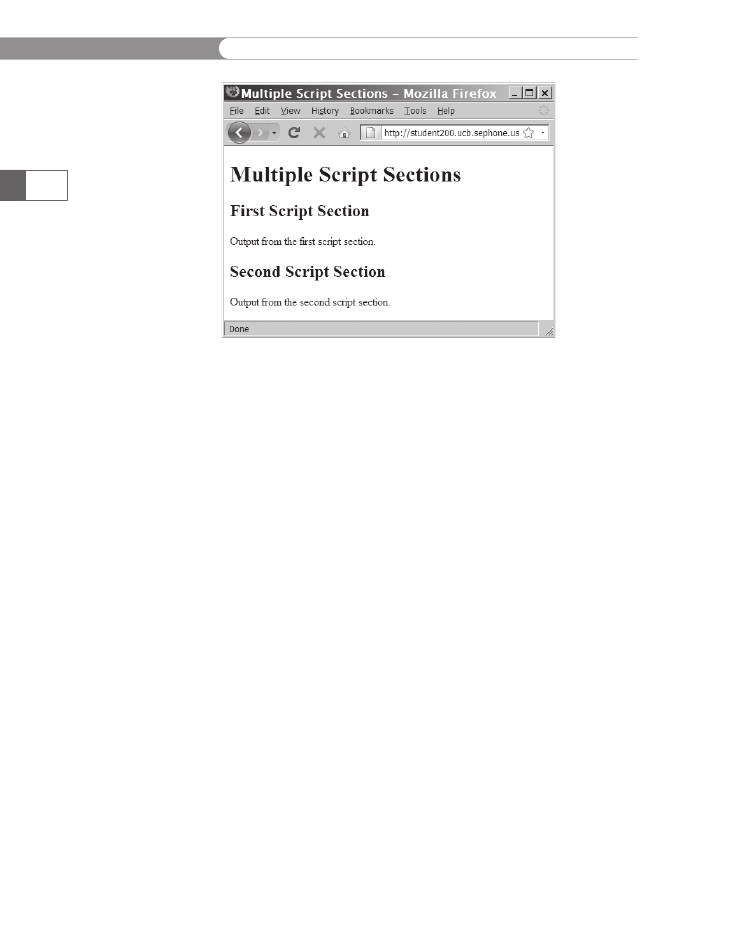
CHAPTER
1
Getting
Started with PHP
18
Figure
1-9
Output
of a document with two PHP script sections
Even
though many people may enjoy talking like a pirate, the
PirateTalk.php
document is of limited use in demonstrating how
to
write PHP scripts. Therefore, in the next exercise, you will write
a
PHP script that displays the results of several built-in PHP func-
tions
using multiple script sections. You will use the phpversion(),
zend_version(),
and ini_get()
functions.
The phpversion() func-
tion
returns the version of PHP that processed the current page. The
zend_version()
function returns the version number of the Zend
Engine,
which is PHP’s scripting engine. The ini_get() function
returns
the value assigned to a directive in the php.ini configuration
file.
You need to pass the name of a directive to the ini_get()
func-
tion,
surrounded by quotation marks.
To
create a script with multiple script sections:
1.
2.
Create
a new document in your text editor.
Type
the <!DOCTYPE>
declaration,
<html>
element,
header
information,
and <body>
element.
Use the strict DTD and
“PHP
Environment Info” as the content of the
element.
Add the following heading element to the document body:
<h1>PHP Environment Info</h1>
3.
Creating
PHP Code Blocks
4.
Add
the following elements, text, and PHP code block to the
document
body. The code block displays the PHP version
number
using the phpversion()
function.
<p>This
page was rendered with PHP version
<?php
echo
phpversion();
?>.
</p>
19
5.
Add
the following elements, text, and PHP code block to the
end
of the document body. The code block displays the Zend
Engine
version number using the zend_version()
function.
<p>The
PHP code was rendered with Zend Engine
version
<?php
echo
zend_version();
?>.
</p>
6.
Finally,
add the following elements, text, and PHP code blocks
to
the end of the document body. The code blocks use the
ini_get()
function
to display PHP’s default MIME type and
the
maximum amount of time that a PHP script is allowed to
execute.
<p>PHP's
default MIME type is
<?php
echo
ini_get("default_mimetype");
?>.
</p>
<p>The
maximum allowed execution time of a PHP
script
is
<?php
echo
ini_get("max_execution_time");
?>
seconds.</p>
7.
Save
the document as MultipleScripts.php in the Chapter
directory
for Chapter 1. After you save and upload the docu-
ment,
validate it with the W3C XHTML Validator.
Open
the MultipleScripts.php file from your Web server
by
entering the following URL: http://<yourserver>/
PHP_Projects/Chapter.01/Chapter/MultipleScripts.php.
Your
Web browser should appear similar to Figure 1-10.
8.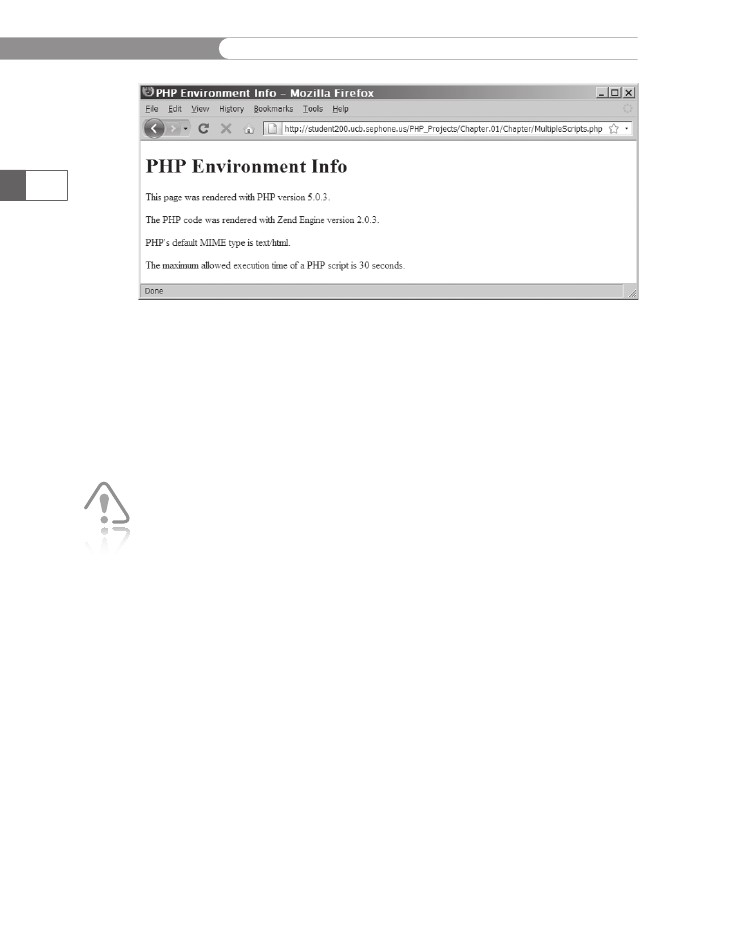
CHAPTER
1
Getting
Started with PHP
20
Figure
1-10
Web
page with multiple PHP scripts
9.
Close your Web browser window.
Case
Sensitivity in PHP
Unlike
XHTML and JavaScript, programming language constructs in
PHP
are mostly case insensitive, although there are some exceptions.
This
means that you can use any of the following versions of the echo
statement
without receiving an error message:
<?php
echo
"<p>Explore <strong>Africa</strong>, <br
/>";
Echo
"<strong>South America</strong>, <br />";
ECHO
" and <strong>Australia</strong>!</p>";
?>
Exceptions
to PHP’s
case insensi-
tivity include
variable and
constant
names, which are case
sensitive. You will study
variables and constants
later in this chapter.
Even though you can use whatever case you want, be certain to use
the letter cases presented in this book for consistency and to make it
easier to locate any problems in your scripts.
Adding Comments to a PHP Script
When you write a script, whether in PHP or any other programming
language, it is considered good programming practice to add com-
ments to your code. Comments are lines you place in your code that
do not get executed, but provide helpful information. Comments
include the name of the script, your name and the date you created
the program, notes to yourself, or instructions to future programmers
who might need to modify your work. When you are working with
long scripts, comments make it easier to understand how a program
is structured.

